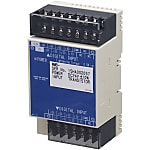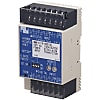(!)NOTE : Windows 7 users won’t be able to use some latest features of eCatalog/WOS since Microsoft is ending support for Windows 7 on 14 Jan, 2020. Please upgrade your system for uninterrupted services.
- Notice of End of Sales for Economy Series Pneumatic Equipment Category. More information.
WATANABEDENKI PLC (Input/Output Units)(Protection function:None)
Brand |
|
|---|---|
| CAD |
|
| Days to Ship |
|
1 items
- Sort By
-
You can add up to 6 items per a category to the compare list.



WMB-DI16, Digital Input Module (16 Points)
WATANABEDENKI
Ideal for distributed installation in the FA/BA field.
This device is a module for inputting ON/OFF signals from relay contacts or open collectors.
It can also input and integrate signals from devices that output pulses.
[Features]
● Digital inputs 1 to 16ch can be used as pulse inputs as well.
● Data monitoring and various settings are possible by connecting a Modbus setting display (WMB-DM01: sold separately) or a setting tool (WRS-MST: free download).
● Can be used as a contact point 32ch input module by connecting an expansion module.
● The terminal block and main body are detachable to facilitate maintenance.
● Integrated values are stored in nonvolatile memory at times of power outages.- CAD :
- 2D
Number Of Inputs Input Format Rated Input Voltage(V) Input answer time Number of Outputs Output Format Rated load voltage(V) Protection function Connection Terminal Representative Standard 16 DC input DC24V - - - - None Terminal Block - From: ₹ 28,051.64 Days to Ship: 24 Day(s) or more  24 Day(s) or more
24 Day(s) or more
| Brand |
|---|
| Product Series |
| CAD |
| From |
| Days to Ship |
| Number Of Inputs |
| Input Format |
| Rated Input Voltage(V) |
| Input answer time |
| Number of Outputs |
| Output Format |
| Rated load voltage(V) |
| Protection function |
| Connection Terminal |
| Representative Standard |
You can add up to 6 items per a category to the compare list. | |
| Brand | WATANABEDENKI |
| Product Series | |
| CAD |
|
| From | ₹ 28,051.64- |
| Days to Ship | 24 Day(s) or more |
| Number Of Inputs | 16 |
| Input Format | DC input |
| Rated Input Voltage(V) | DC24V |
| Input answer time | - |
| Number of Outputs | - |
| Output Format | - |
| Rated load voltage(V) | - |
| Protection function | None |
| Connection Terminal | Terminal Block |
| Representative Standard | - |
Loading...
Configure
Specification/Dimensions
-
Number Of Inputs
-
Input Format
- DC input
- AC input
- AC/DC input
-
Rated Input Voltage(V)
-
Input answer time
- Less than 50 to 100 mS
-
Number of Outputs
-
Output Format
- Relay contact output
- Triac output
- Transistor / source output
- Transistor / sync output
- Other
-
Rated load voltage(V)
-
Protection function
- None
- Output protection function
-
Connection Terminal
- Terminal Block
- Connector
-
Representative Standard
- CE
- UL
- CUL
- CSA
Narrow search by specifying Manufacturer
-
- MITSUBISHI (4)
- WATANABEDENKI (1)
- OMRON (0)
Related Categories to PLC (Input/Output Units)
FAQ PLC (Input/Output Units)
- Question: What is a PLC (Programmable Logic Controller) and How Do Input/Output Units Function in Automated Systems?
- Answer: A PLC, or Programmable Logic Controller, is the brains behind many automated systems. It's like a specialized computer designed for controlling machines and processes. PLCs use Input/Output (I/O) units to communicate with sensors and actuators in the actual system. These I/O units serve as the interface between the digital world of the PLC and the physical world of your machines. Inputs gather data from sensors, while outputs send control signals to devices like motors and valves, allowing the PLC to make decisions and automate tasks.
- Question: How Do PLC Input/Output Units Interface with Devices and Sequencers in Industrial Automation?
- Answer: PLC I/O units interface with devices through wiring connections. Inputs are connected to sensors or switches, while outputs are linked to devices like motors, valves, or lights. The PLC's programming defines how inputs and outputs interact. For example, an input from a temperature sensor might trigger an output to turn on a cooling fan. PLCs can also work in sequence, performing a series of tasks based on inputs and previous outcomes. This sequence can be programmed to control complex industrial processes.
- Question: How Do I Install and Program PLC Input/Output Units for Optimized Control in Automated Machinery?
- Answer: Installing PLC I/O units involves mounting them in a control panel, connecting wires, and ensuring proper electrical connections. To program a PLC for optimized control, you'll use specialized software to create a logic program. This program defines how the PLC responds to different inputs and manages outputs. It's essential to understand your machinery's requirements, design a logical program, and thoroughly test it to ensure efficient and safe operation.
- Question: In Which Industrial Applications Are PLCs Commonly Used?
- Answer: PLCs are incredibly versatile and can be found in various industrial applications. They're widely used in manufacturing for tasks like assembly line control and quality assurance. They're also essential in processes like water treatment, energy production, and food production. Basically, anywhere automation and precise control are needed, you'll often find PLCs at the heart of the operation.







How can we improve?
How can we improve?
Thank you for your time.
Your feedback is essential for our continuous improvement
Privacy Policy
Thank you for your cooperation.
Thank you for your time.
Your feedback is essential for our continuous improvement
Please use the inquiry form.
Privacy Policy